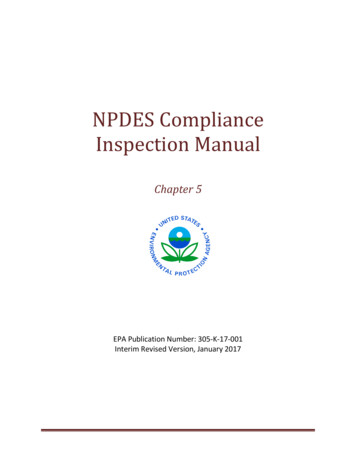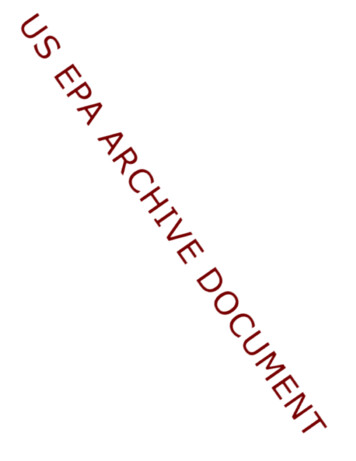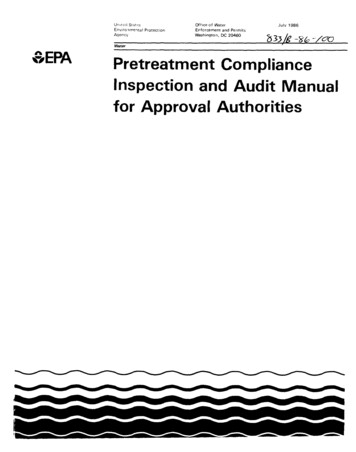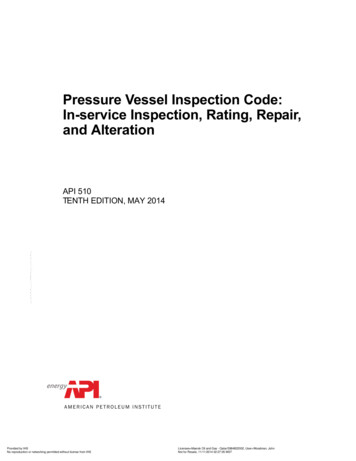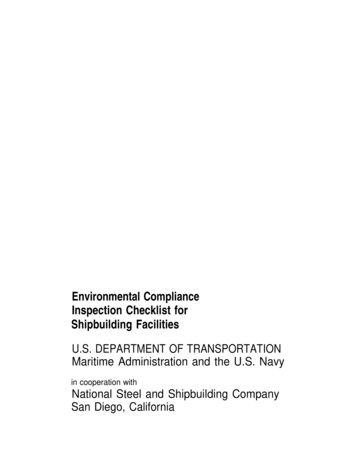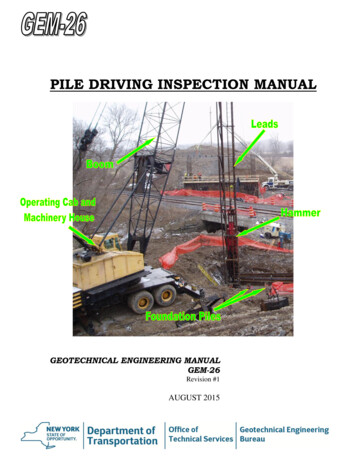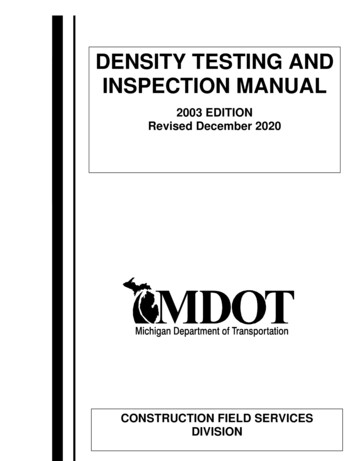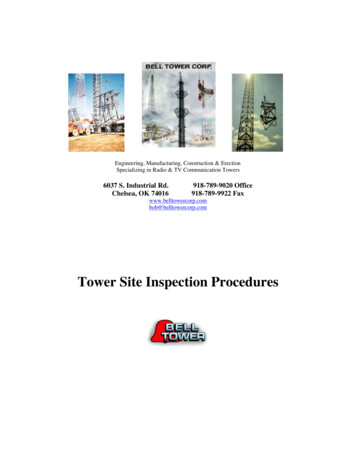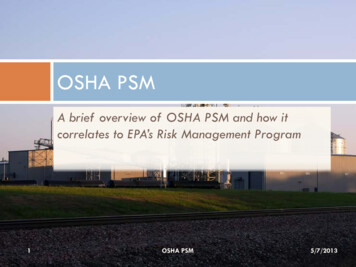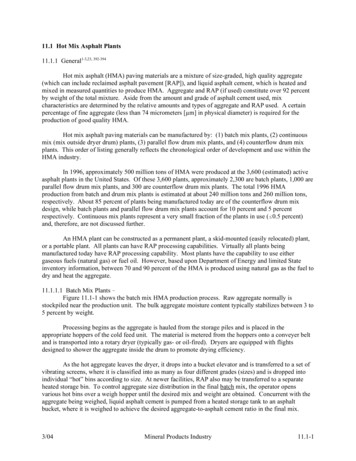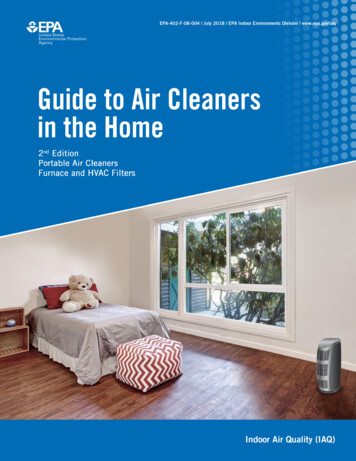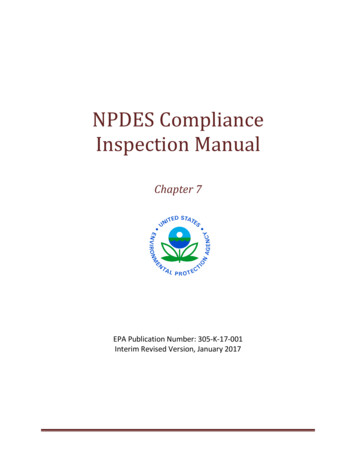
Transcription
NPDES ComplianceInspection ManualChapter 7EPA Publication Number: 305-K-17-001Interim Revised Version, January 2017
U.S. EPA Interim Revised NPDES Inspection Manual 2017CHAPTER 7 –LABORATORY PROCEDURES AND QUALITYASSURANCEContentsA. Objectives and Requirements . 134B. Sample Handling Procedures . 134Evaluation of Permittee Sample Handling Procedures . 134C. Laboratory Analyses Techniques Evaluation. 135Evaluation of Permittee Laboratory Analytical Procedures . 135Evaluation of Permittee Laboratory Facilities and Equipment . 136D. Quality Assurance and Quality Control . 138Evaluation of the Precision and Accuracy of the Permittee Laboratory . 138Example of Laboratory QA/QC Measures for Microbial Analyses . 140Evaluation of Permittee Data Handling and Reporting . 140Evaluation of Permittee Laboratory Personnel . 141Evaluation of Contract Laboratories . 141Overview of the Discharge Monitoring Report Quality Assurance Program and HowIt Relates to the Inspection Program. 141E. References. 142F. Laboratory Quality Assurance Checklist . 144Chapter 7 – Page 133
U.S. EPA Interim Revised NPDES Inspection Manual 2017A.OBJECTIVES AND REQUIREMENTSThe analytical laboratory provides both qualitative and quantitative information fordetermining the extent of permittee compliance with permit discharge requirements. To bevaluable or useful, the data must be representative and accurately describe the characteristicsand concentrations of constituents in the samples submitted to the laboratory. The objectivesof laboratory Quality Assurance (QA) are to monitor and document the accuracy and precisionof the results reported and to meet reliability requirements.QA refers to a total program for ensuring the reliability of data by utilizing administrative andtechnical procedures and policies regarding personnel, resources, and facilities. QA is requiredfor all functions bearing on environmental measurements and includes activities such asproject/study definition; sample collection and tracking; laboratory analysis; data validation,analysis, reduction, and reporting; documentation; and data storage systems. Thus, the QAprogram is designed to evaluate and maintain the desired quality of data. Quality Control (QC),a function of QA, is the routine application of procedures for controlling the accuracy andprecision of the measurement process and includes the proper calibration of instruments andthe use of the appropriate analytical procedures.The regulations at Title 40 of the Code of Federal Regulations (CFR), section 122.41(e)(conditions applicable to all permits), requires adequate laboratory and process controls,including appropriate QA/QC procedures. Each permittee's laboratory must have a QA/QCprogram. The laboratory must document the QA/QC program in a written QA/QC manual andthe laboratory should make it available to all personnel responsible for sample analyses. Themanual must clearly identify the individuals involved in the QA program and document theirresponsibilities. The laboratory's standard operating procedures must meet user requirementsin terms of specificity, completeness, precision, accuracy, representativeness, andcomparability of the required testing procedures. The laboratory should devote approximately10 to 20 percent of their resources to their QA/QC program.Guidance in this chapter is broad-based and may not be applicable to every laboratory. Thischapter includes a Laboratory Quality Assurance Checklist for the inspector's use at the end ofthe chapter. For detailed information concerning laboratory QA/QC, refer to EnvironmentalProtection Agency's (EPA's) Handbook for Analytical Quality Control in Water and WastewaterLaboratories (EPA, 1979) and EPA's National Pollutant Discharge Elimination System (NPDES)Compliance Monitoring Inspector Training Module: Laboratory Analysis (EPA, 1990). If a moredetailed assessment of a laboratory is required, personnel with more extensive knowledge ofthe methodologies should perform the inspection.B.SAMPLE HANDLING PROCEDURESEVALUATION OF PERMITTEE SAMPLE HANDLING PROCEDURESProper sample handling procedures are necessary in the laboratory from the sample's receiptto its discard. Sample handling procedures for small permittees may differ from procedures forlarger permittees because staff organizational structures and treatment facility designs varyChapter 7 – Page 134
U.S. EPA Interim Revised NPDES Inspection Manual 2017from one facility to the next. However, proper sample handling procedures should bestandardized, utilized and documented by all permittees. In evaluating laboratory samplehandling procedures, the inspector should verify the following: The laboratory area is secure and restricts entry to authorized personnel only. The laboratory has a sample security area that is dry, clean, and isolated; has sufficientrefrigerated space; and can be locked securely. The laboratory has a sample custodian and a back-up custodian. The custodian receives all incoming samples, signs the chain-of-custody record sheetaccompanying the samples, and locks the samples in the sample security arearefrigerator. The custodian ensures that samples are properly stored. The custodian performs or analyzes checks of proper preservation, container type, andholding times and documents the results. The custodian distributes and retrieves samples to and from personnel who perform theanalyses (i.e., analysts) and documents the transfer of the samples in the chain-ofcustody record, which is retained as a permanent record. The chain-of-custody recordtypically identifies the sample identification number, sample collection date and time,sample type, sample location, sample volume, and preservatives. The custodian and analysts ensure the minimum possible number of people handle thesamples. The custodian only disposes of samples and records upon direction from the laboratorydirector, in consultation with previously designated enforcement officials, when it iscertain that the information is no longer required or that the samples have deteriorated.C.LABORATORY ANALYSES TECHNIQUES EVALUATIONEVALUATION OF PERMITTEE LABORATORY ANALYTICAL PROCEDURESThe permittee's laboratories or its contract laboratories must use uniform methods, thus,eliminating methodology as a variable when data are compared or shared among laboratories.The permittee's laboratory must consult 40 CFR Part 136 for the alternative methods approvalprocess. A permittee may only use alternative test procedures if the procedures have EPAapproval, as specified by 40 CFR 136.4 and 136.5, and promulgated under Public Law (PL)92-500.Many standardized test procedures promulgated under 40 CFR Part 136 are covered in EPA’sMethods for Chemical Analysis of Water and Wastes (EPA, 1983) and the latest acceptededition of Standard Methods for the Examination of Water and Wastewater (American PublicHealth Association (APHA), American Water Works Association (AWWA), and WaterEnvironment Federation (WEF), 2013). Revisions and new additions to this manual are madewhenever new analytical techniques or instruments are developed. These are consideredChapter 7 – Page 135
U.S. EPA Interim Revised NPDES Inspection Manual 2017accepted after final publication in the Federal Register. 3 Other approved methods from UnitedStates Geological Survey (USGS), American Society for Testing and Materials (ASTM), andseveral commercial vendor methods are also referenced in 40 CFR Part 136.In evaluating laboratory analytical procedures, the inspector should verify the following: The laboratory personnel follow analytical methods specified in the most current 40 CFRPart 136. The laboratory personnel properly perform any deviations allowed by 40 CFR Part 136and maintain documentation of any EPA-approved deviation from specified procedures. The laboratory personnel follow QA/QC procedures that conform to the proceduresspecified in the permit, analytical method, or methods compendium for approved 40CFR Part 136 methods from a consensus organization. For example, the StandardMethods for the Examination of Water and Wastewater (APHA, AWWA, and WEF)contains QA/QC procedures. The laboratory personnel maintain a QA/QC record on reagent preparation, instrumentcalibration and maintenance, incubator temperature, and purchase of supplies. The laboratory personnel conduct QA/QC checks on materials, supplies, equipment,instrument calibration and maintenance, facilities, analyses, and standard solutions.EVALUATION OF PERMITTEE LABORATORY FACILITIES AND EQUIPMENTTo verify that the proper analytical procedures are being followed, the inspector should havethe responsible analyst describe each of the procedures. The inspector should be alert to anydeviation from the specified analytical method. Any questions regarding the proper procedurescan be resolved by referring to the cited methodology. Even simple analyses can yield invalidresults if the methodology cited in 40 CFR Part 136 is not exactly followed. Certain requireddeviations from the approved methods are cited in 40 CFR Part 136, notes.Laboratory ServicesThe availability of laboratory services affects data reliability. In evaluating laboratory services,the inspector should verify that the laboratory provides the following: 3Adequate supply of laboratory pure water, free from chemical interferences and otherundesirable contaminants. The laboratory personnel should check water qualityroutinely and document it.Adequate bench, instrumentation, storage, and recordkeeping space.Clean and orderly work area to help avoid contamination.Adequate circulation and egress.Adequate humidity and temperature control.Adequate lighting and ventilation.The most current 40 CFR Part 136 may supersede any method or technique cited in this manual.Chapter 7 – Page 136
U.S. EPA Interim Revised NPDES Inspection Manual 2017 Dry, uncontaminated compressed air when required.Efficient fume hood systems.Necessary equipment such as a hot plate, incubator, water bath, refrigerator forsamples, glassware, pH meter, thermometer, balance, etc.Electrical power for routine laboratory use and, if appropriate, voltage-regulatedsources for delicate electronic instruments.Vibration-free area for accurate weighing.The inspector should also check that the laboratory personnel use proper safety equipment(e.g., lab coats, gloves, safety glasses, goggles, and fume hoods) where necessary. The inspectorshould document any problems and refer to the proper authority (e.g., Occupational Safety andHealth Administration (OSHA)).Instruments and EquipmentInstrumentation is extremely important in the analytical laboratory. To a certain extent,analytical instrumentation is always developmental; manufacturers are continually redesigningand upgrading their products, striving for miniaturization, enhanced durability and sensitivity,and improved automation. In evaluating laboratory instruments and equipment, the inspectorshould verify the following: The laboratory personnel follow standard and specific procedures for selecting andcleaning glassware and containers. Chapter 2 of EPA's NPDES Compliance MonitoringInspector Training Module: Laboratory Analysis (EPA, 1990) contains detailedinformation on glassware cleaning.The laboratory personnel follow written requirements (e.g., standard operatingprocedures) for daily operation of instruments and equipment.The laboratory contains emergency equipment such as a fire extinguisher, eye washstation, shower, first aid kit, lab coats, gloves, and goggles.Standards and appropriate blanks are available from suppliers to perform standardcalibration procedures. The laboratory personnel should use standard concentrationsthat closely bracket actual sample concentrations. Sources of standards are documentedand where possible, traceable to a national standard (e.g., National Institute ofStandards and Technology (NIST).The laboratory personnel maintain records of each set of analyses performed includingthe order in which calibration, QA/QC, and samples were analyzed (i.e., analysis run logsor instrument run logs).The laboratory personnel follow written troubleshooting procedures to identifycommon equipment malfunctions.The laboratory personnel follow written schedules for replacement, cleaning, checking,and/or adjustment by service personnel.The laboratory personnel maintain documentation on equipment maintenance andservice checks.Chapter 7 – Page 137
U.S. EPA Interim Revised NPDES Inspection Manual 2017Commonly used analytical instruments include analytical balances, pH meters, dissolved oxygenmeters, conductivity meters, turbidity meters, spectrophotometers, atomic absorptionspectrophotometers, organic carbon analyzers, selective ion analyzers, gas-liquidchromatographs, titrimetric analyses, and temperature controls. Chapter 2 of EPA's NPDESCompliance Monitoring Inspector Training Module: Laboratory Analysis (EPA 1990) includes adetailed discussion on these instruments.SuppliesChemical reagents, solvents, and gases are available in many grades of purity, ranging fromtechnical grade to various ultrapure grades. The purity of the materials required in analyticalchemistry varies with the type of analysis. The parameter being measured, the analyticalmethod, and the sensitivity and specificity of the detection system determine the purity of thereagents required. Do not use reagents of lesser purity than that specified by the method. Inevaluating laboratory supplies, the inspector should verify that the laboratory personnel: Check the accuracy of purchased solutions as per method requirements.Prepare stock solutions and standards using volumetric glassware.Prepare and standardize reagents against reliable primary standards.Use the required reagent purity for the specific analytical method.Check working standards frequently to determine changes in concentration orcomposition.Verify concentrations of stock solutions before being used to prepare new workingstandards.Label standards and reagents properly including the preparation date, concentration,the analyst's identification, storage requirements, and discard date.Store standards, reagents, and solvents in appropriate containers and under requiredmethod conditions and manufacturer’s directions. If conditions are not specified, storestandards and reagents according to 40 CFR Part 136, Table II.Store standards, reagents and solvents using clean containers of suitable compositionwith tight-fitting stoppers.Discard standards and reagents after recommended shelf-life has expired or when signsof discoloration, formation of precipitates, or significant changes in concentrations areobserved.D.QUALITY ASSURANCE AND QUALITY CONTROLEVALUATION OF THE PRECISION AND ACCURACY OF THE PERMITTEE LABORATORYThe purpose of laboratory control procedures is to ensure high-quality analyses using controlsamples, control charts, reference materials, and instrument calibration. The laboratory mustinitiate and maintain controls throughout the analysis of samples. Specifically, each testingbatch must contain at least one blank, standard, duplicate, and spiked (as applicable) sampleanalysis. When a batch contains more than 10 samples, every tenth sample should be followedby a duplicate and a spike (as applicable). Consult each method for specific QC requirements.Chapter 7 – Page 138
U.S. EPA Interim Revised NPDES Inspection Manual 2017The precision of laboratory findings refers to the reproducibility or degree of agreement amongreplicate measurements of the same quantity. The closer the numerical values of themeasurements come to each other, the more precise the measurements are. In a laboratory QCprogram, precision is determined by the analysis of actual samples in duplicate. These mayrepresent a range of concentrations and a variety of interfering materials usually encounteredduring the analysis. Accuracy refers to the degree of difference between observed values andknown or actual values. The closer the value of the measurement comes to the actual value,the more accurate the measurement is. The accuracy of a method can be determined byanalyses of samples to which known amounts of reference standards have been added (spikedsamples).In evaluating the precision of the measurement process, the inspector should verify that thelaboratory personnel: Introduce duplicate samples into the train of actual samples at least 10 percent of thetime to monitor the performance of the analytical system. Prepare and use precision control charts or other statistical techniques for eachanalytical procedure. Develop precision control charts by collecting data from aminimum of 15 to 20 duplicate samples (run in controlled conditions) over an extendedperiod (e.g., 10 to 20 days). Statistical methods include calculation of mean, standarddeviation, and variance to define the range and variability of the data. Take corrective actions when data fall outside the warning and control limits. Document out-of-control data, the situation, and the corrective action taken.In evaluating accuracy of the measurement process, the inspector should verify that thelaboratory personnel: Introduce spiked samples into the train of actual samples at least 10 percent of the timeto monitor the performance of the analytical system. In the spiked samples, the amountof additive is appropriate to the detection limit and sample concentration. Prepare and use accuracy control charts for each analytical procedure. Develop accuracycontrol charts by collecting data from a minimum of 15 to 20 spiked samples (run incontrolled conditions) over an extended period.Establish accuracy limits (as percent recovery) based on standard deviations whoseupper and lower control limits are three times the standard deviation above andbelow the central line.– Establish the upper and lower warning limits at twice the standard deviation aboveand below the central line. Note: Some parameters have a defined warning limitrequired by 40 CFR Part 136.– Take corrective actions when data fall outside the warning and control limits.Document out-of-control data, the situation, and the corrective action taken.Chapter 7 – Page 139
U.S. EPA Interim Revised NPDES Inspection Manual 2017EXAMPLE OF LABORATORY QA/QC MEASURES FOR MICROBIAL ANALYSESAs an example of the laboratory quality measures an inspector might evaluate, the followingdiscussion applies to microbial analysis. Microbial contamination is a common concern relatedto animal feeding operations and sanitary treatment systems covered by the NPDES standards.Common microbial contaminants of concern in wastewater and sewage sludge include totalcoliform, fecal coliform, and enterococci. Appropriate microbial laboratory control measuresthe inspector should verify include the use by laboratory personnel of: Positive and negative controls—controls are known cultures that are analyzed exactlylike a field sample and wil
(e.g., lab coats, gloves, safety glasses, goggles, and fume hoods) where necessary. The inspector should document any problems and refer to the proper authority (e.g., Occupational Safety and Health Administration (OSHA)). Instruments and Equipment Instrumentation is extremely imp
